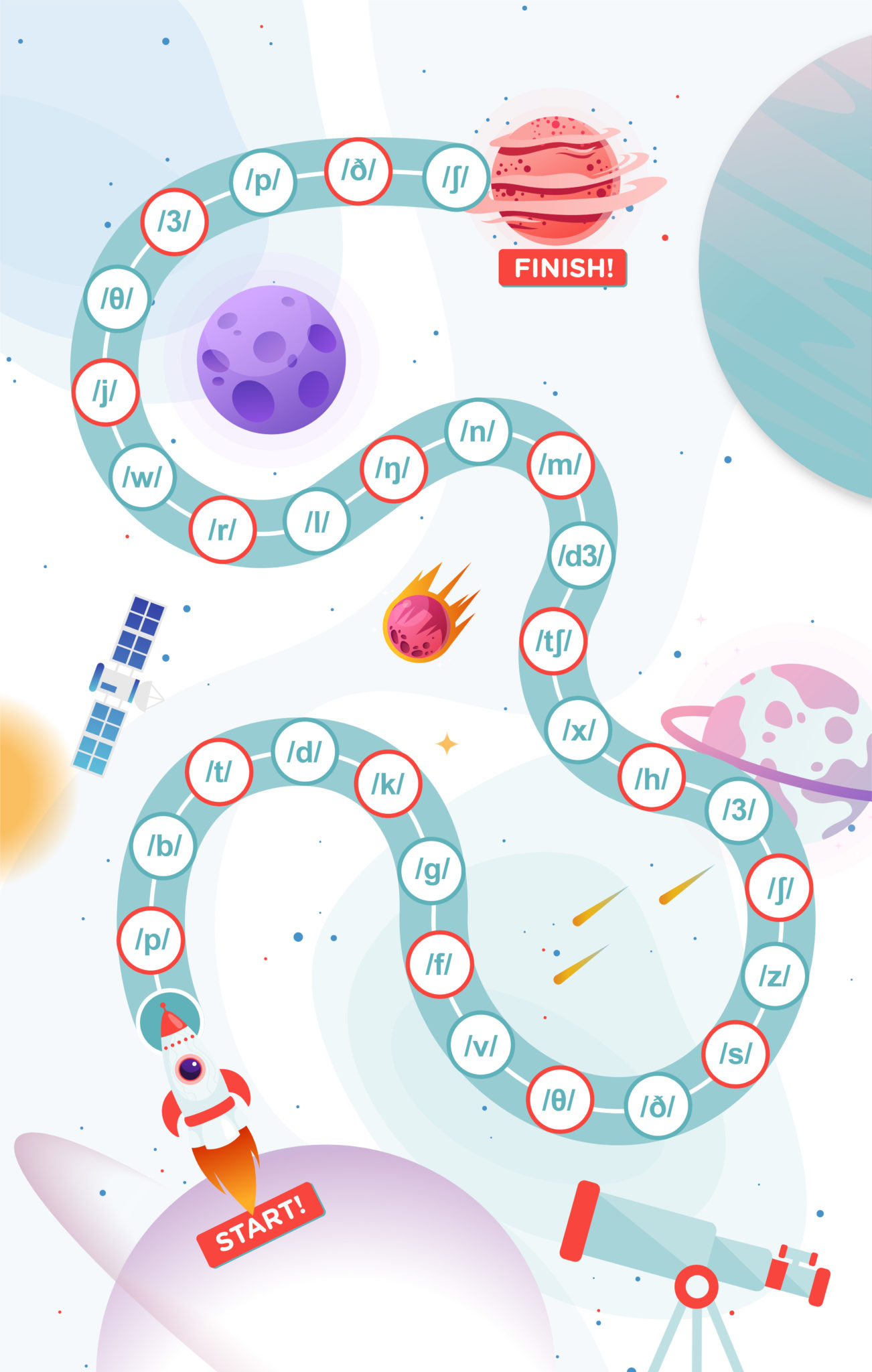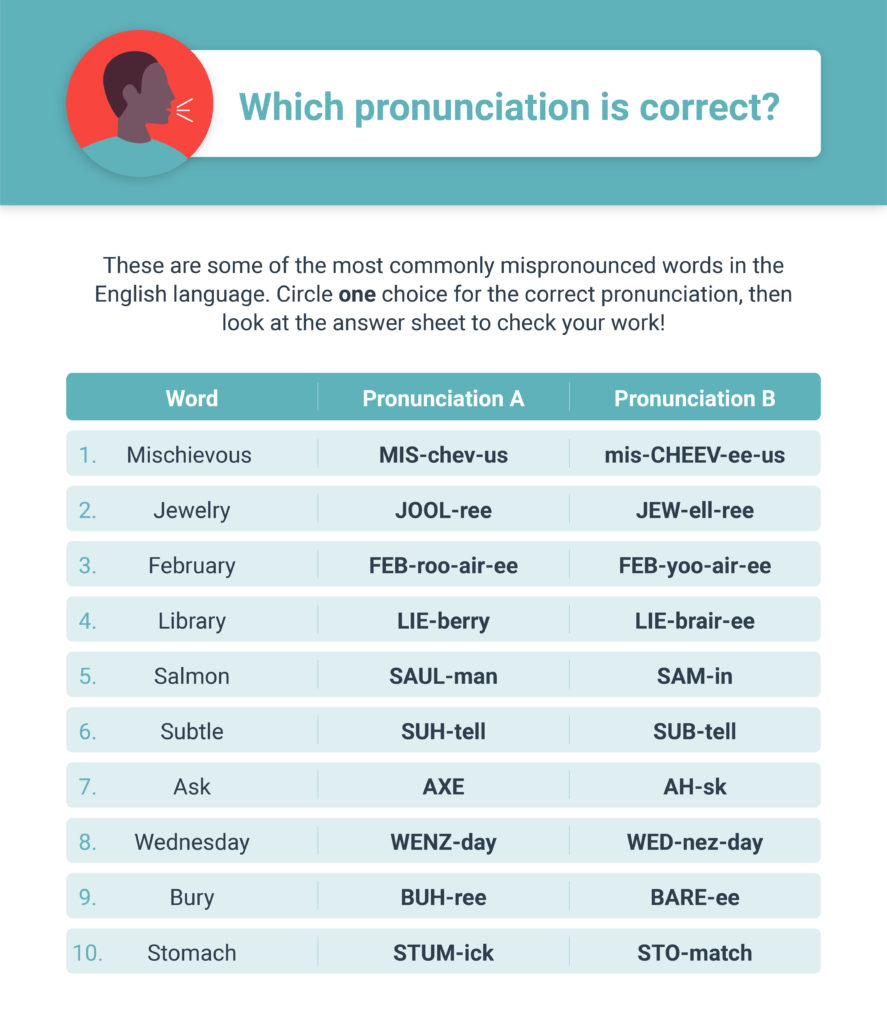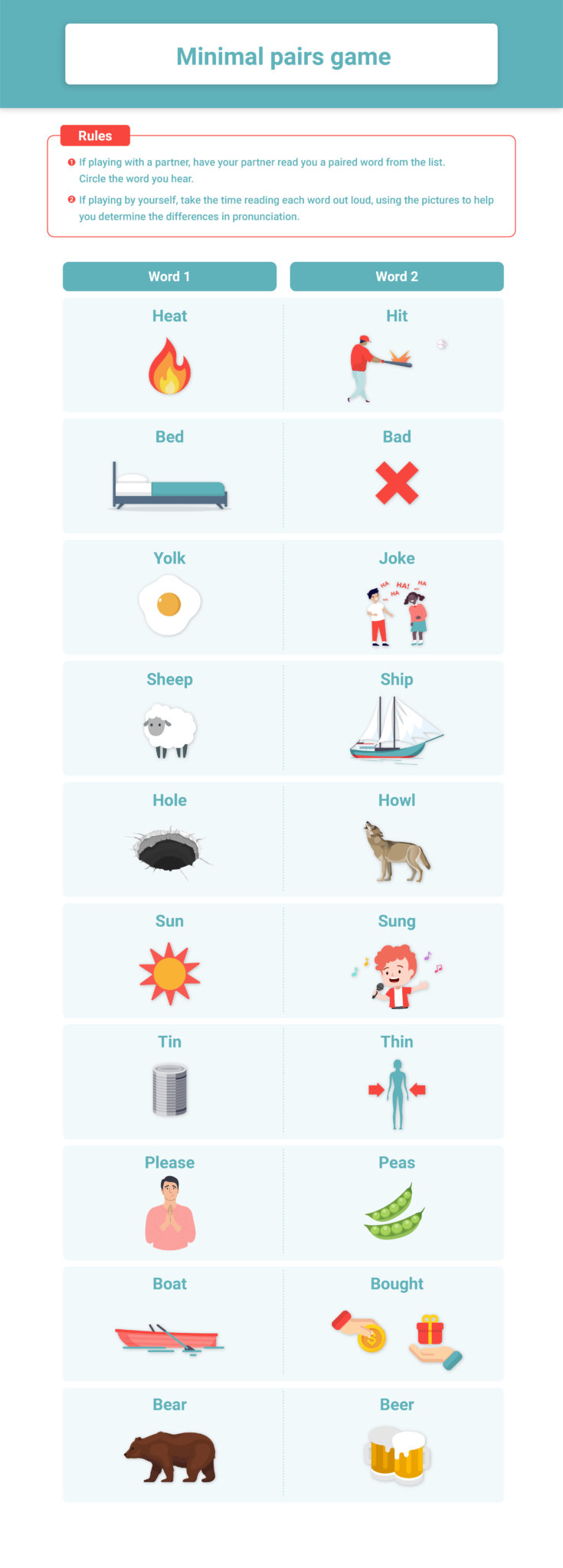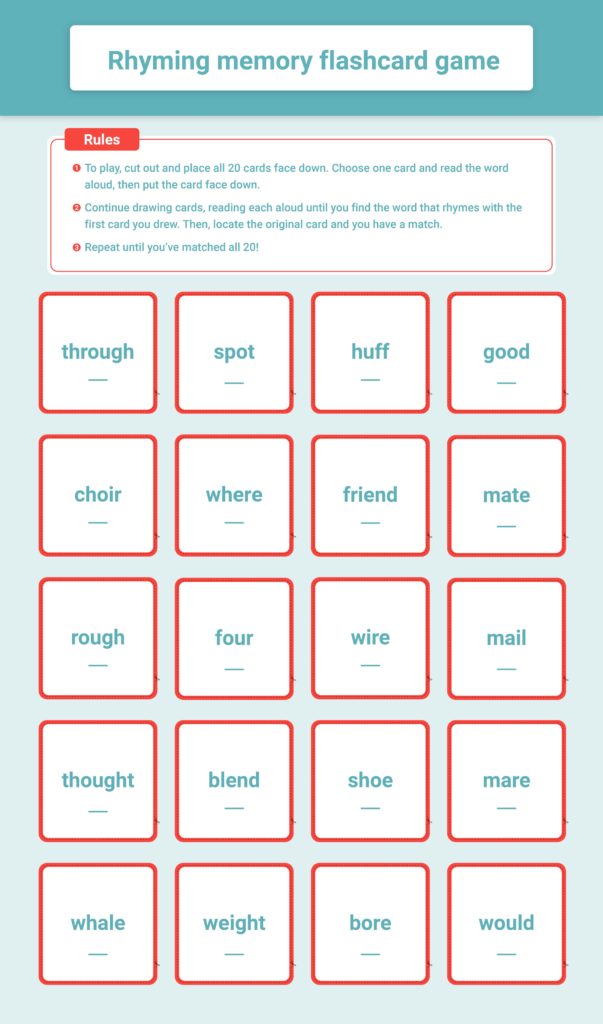
By
Last updated:
May 5, 2022
It’s a common situation among English learners: You’re excited to practice your pronunciation, but there’s nobody you can talk to.
But did you know you can actually do a lot of pronunciation practice on your own?
These are my favorite activities to do when I don’t have anyone to practice my English with—I hope you’ll find them useful.
Contents
- 1. Reverse Dictation
- 2. Act It Out
- 3. Minimal Pairs
- 4. Sound Mastery
- 5. Sing Along
- 6. Tongue Twisters
- 7. Where’s the Stress?
- 8. Your Day in a Haiku
- 9. Do-it-yourself Interview
- 10. Backchaining
Download:
This blog post is available as a convenient and portable PDF that you
can take anywhere.
Click here to get a copy. (Download)
1. Reverse Dictation
Goal: To check how easily understandable your pronunciation is
Phones are the ultimate gadget for studying. You can use your phone to review flashcards, check the dictionary and—yes—even to test your English pronunciation.
One way to do this is through reverse dictation. Dictation means to listen to someone speaking and then write down what they say.
Reverse dictation turns that around. This time, it’s you who has to speak—and your phone will be the one writing down what you say.
This is doable through the speech recognition feature, which is present in pretty much all modern phones. Here are the instructions for Android and iPhone.
You can then say simple sentences or even dictate a whole grocery list out loud! If your phone ends up misspelling a word, then most likely your pronunciation of that word is less clear. The beauty of this method is that you can repeat the sentence until your phone recognizes every word perfectly.
2. Act It Out
Goal: To pick up natural intonation and body language
English movies and TV series are some of the most fun learning materials you can use!
However, for this activity, you’ll be going beyond passive listening. Instead, you’ll have to pick a specific movie scene and give each line your full attention. To make it easier, turn on the subtitles.
Here’s a movie clip you can start with:
Listen closely to each line, then hit pause and repeat exactly how the actor said the line. There’s a little bit of acting involved! You won’t only be imitating the pronunciation but also the intonation and emotion behind the line.
This is an interesting clip to practice with because you’ll be going back and forth between Miranda (the strict interviewer) and Andy (the job applicant). They have different mannerisms and even different ways of speaking.
To take your pronunciation practice even further, you can even try dubbing on the second pass. Put the clip on mute, then say each character’s line in real time. Do your best to match your speech with their mouth movements.
3. Minimal Pairs
Goal: To clear up the confusion with similar sounds
Minimal pairs are two words in English that are almost the same except for one sound. It’s very common for English learners get these words mixed up.
For example, most English learners (myself included!) have struggled at some point with minimal pairs such as reach vs. rich and feet vs. fit.
Here are some other examples:
- lot vs. rot
- sink vs. think
- pun vs. pan
To conquer minimal pairs, turn them into a sort of tongue twister or warm-up exercise.
Pick one to five minimal pairs. Say each pair repeatedly and as fast as you can while still maintaining proper pronunciation. You can do this every morning or whenever you start practicing your English.
This forces you to distinguish between the two words. The next time either word comes up in a conversation, you’ll be able to pronounce it much more accurately.
4. Sound Mastery
Goal: To focus on a single sound in English
Regardless of your level of proficiency in English, there might still be a few sounds that you’re having a hard time with. Usually, what makes these sounds so difficult is that you’re not used to pronouncing them.
To make these sounds more familiar, the key is repetition. Take one sound that you’re not as comfortable with and make a list of words with that sound. Then write down each word on an index card.
Then you should scatter these cards into places where you’ll see them every day. You might put one index card in your bathroom, another inside your wallet and a third one on your computer.
Whenever you see a card, say the word on the card out loud. Every time you encounter the words, you’ll get more and more confident with pronouncing the sound!
5. Sing Along
Goal: To practice connected speech
Choose a song that you like so much you could listen to it over and over. For example, I’m a fan of Michael Jackson songs, so I might start there.
Once you have a song, play it and listen for any connected speech. In English, words can sometimes flow into each other, as if there’s no space between them. The phrase fall in love has three words, but it’s often pronounced as “fallin love.”
This might not feel natural for you to do at first. But native English speakers do it all the time! It’s easier to notice and imitate connected words in songs, especially with the chorus.
Finally, sing along with the song while making sure that you’re also connecting your speech at the right places. In the song above, the phrases dream of you and miss a thing are examples of connected speech.
6. Tongue Twisters
Goal: To train your mouth to get used to English
Tongue twisters are one of the most time-tested pronunciation exercises around. After all, it’s not just language learners who use them. Tongue twisters show up frequently as party games, and public speakers often use them to prepare for speeches!
Many tongue twisters don’t make much sense in their meanings. That’s because the whole point of a tongue twister is the sound. Tongue twisters repeat the same sound in almost every word.
Here are some tough tongue twisters:
Frivolous fanciful Fannie fried fresh fish furiously.
How many snacks could a snack stacker stack, if a snack stacker snacked stacked snacks?
If two witches would watch two watches, which witch would watch which watch?
Say each tongue twister slowly at first, then speed up until you reach the fastest speed you can go!
For more of these, there are handy apps (Android and iPhone) that sort tongue twisters by level.
7. Where’s the Stress?
Goal: To get used to proper word stress
Whatever your native language is, there’s one part of English pronunciation that probably didn’t come naturally to you at first: word stress. This refers to the syllable in a word that’s emphasized (spoken the strongest or loudest).
Here’s word stress in action:
- blanket
- amazed
- psychology
Wrong word stress is one of the most common pronunciation mistakes people make. That’s not surprising considering how random word stress seems to be in English!
Here’s what you can do: Grab an English book or article that you can read and then pick a single paragraph. Look out for words with multiple syllables and mark the word stress in all of them.
Let’s take this sentence from “The Curious Incident of the Dog in the Night-time”:
I came home from school one day and no one answered the door, so I went and found the secret key that we keep under a flowerpot behind the kitchen door.
After you’ve marked the word stress on your own, check your dictionary to see if you got each word right. Then read each multisyllabic word out loud, exaggerating the stress. Finally, read the entire passage while keeping the proper word stress in mind!
8. Your Day in a Haiku
Goal: To hone your writing and pronunciation at the same time
Got 15 minutes to spare? This writing exercise doubles as a pronunciation exercise.
The basic idea is to write a quick poem in English about your day. There’s an extra rule, though: you have to write it as a haiku.
A haiku consists of three lines with five syllables in the first line, seven syllables in the second line and five again in the third line.
If you really enjoyed your breakfast, you might write:
I love my breakfast
Scrambled eggs, toast, sausages
Throw in ketchup, too
The results can get wacky! But you’re not done yet.
After writing your haiku, recite it in three different tones. You can do your normal voice first, then play around with different moods: monotone, singsong, happy, angry or whispering.
This will broaden your emotional range when talking in English so your speech will sound more natural.
9. Do-it-yourself Interview
Goal: To become comfortable with expressing yourself in English
One secret to improving your English pronunciation is talking to yourself. And not just in your head, either—I mean talking out loud!
To turn it into a daily practice, make your own little recordings. Each day, answer a specific question in English for two minutes while recording yourself on your phone.
The questions should get you talking about your life, like these:
- How have you changed since last year?
- If you could meet one historical person, who would it be?
- What’s a joke or meme that you recently laughed about?
No need to even come up with them yourself! There are plenty of question lists available online (and yes, these are the same questions people ask at parties or when they want to get to know someone better).
After recording yourself, take a break for at least five minutes to refresh your mind. Then play back the recording and observe how it sounds.
Are there words you’re having trouble with? Did you pause halfway through because you weren’t sure how to express yourself? Write these down as a list of things to work on for your next pronunciation practice.
10. Backchaining
Goal: To smooth out word beginnings and endings
Certain word beginnings and endings in English can be hard to pronounce, especially if they’re not in your native language. For example, some English learners struggle with “s” at the start of a word (school, snake), while others struggle with words ending in consonants (pan, scientist).
If you can relate to this, you can try a more targeted pronunciation exercise: backchaining.
Backchaining is constructing a sentence backwards. You start with the last word, then add the second to the last word and so on until you form the whole sentence.
Here’s how it works:
bucket — the bucket — dropped the bucket — accidentally dropped the bucket — I accidentally dropped the bucket.
You can even do this for individual words: n — an — pan.
This exercise can be very helpful because it forces you to isolate specific sounds and words.
For an added challenge, tell a story while backchaining! Go for at least three sentences. It’s a bit of a mind-bender and you can end up talking about funny scenarios.
You get the best results when you can do some English pronunciation practice every day. Luckily, you won’t always need a conversation partner for this! With the solo exercises above, you can work toward becoming an excellent English speaker whether you’re alone or with other people.
With over 40 separate sounds to learn, it’s no wonder most ESL students struggle to learn correct pronunciation. Some of them find it confusing and many of them just don’t want to put in the time to learn something that’s “not strictly necessary” for communication.
And while most teachers are well aware of the importance of teaching pronunciation, come lesson time, there’s always so much to cover in the ESL classroom that pronunciation practice ceases to be a priority and it’s often relegated to a few rushed minutes in between activities or not covered at all.
Why spend the time on english pronunciation exercises?
Fighting the temptation to consider pronunciation as an “extra” is hard, especially for the learners. Most students who first start to learn English, or any language for that matter, are usually in urgent need for things like words, expressions, maybe a few tenses. At this stage, spending time trying to understand the difference between an S sound and a Z sound seems like nothing but a waste of time. Other students may have been learning English for years without ever focusing on pronunciation, so why would they start now?
But, truth be told, does teaching pronunciation really make a difference?
Absolutely! There are several precious benefits that come from learning correct pronunciation.
- Contrary to what you may believe, learning correct pronunciation will improve your students’ listening comprehension. The obscure sounds that they couldn’t make out once finally take shape and watching a movie in the orginal language is no longer a self inflicted torture but a pleasant a rewarding experience.
- Pronunciation will also help learners with their reading skills since reading, in the end, is the practice of saying things out loud, albeit in your head.
- It makes communicating easier. Not only does it lower the chances for misunderstandings or possibly awkward situations to happen, but it also helps break down cultural barriers, both in everyday life and in business settings.
So now you see how not teaching pronunciation in your ESL classroom would mean doing your students a great disservice.
When and how should we start focusing on pronunciation?
When it comes to teaching pronunciation, the sooner the better. Whatever the age and level of your students, it’s important to include some sort of English pronunciation practice as early as possible in class.
The space and time you decide to give pronunciation is up to you. Ideally, every time you introduce a new language, you should focus on the way it’s pronounced, but that usually ends up being incredibly time-consuming. Instead, you could plan full English pronunciation lessons or dedicate just a few minutes in each class explaining how to pronounce certain words or focusing on specific pronunciation features.
If your learners are teenagers or adults, you will also need to decide whether you want them to become familiar with the IPA (International Phonemic Alphabet). This could prove to be especially useful if you plan to teach the same students over long periods of time, let’s say at least a few months. In this case, correcting pronunciation mistakes becomes a lot more time-effective as, very often, all you’ll need to do is point to the symbol on the IPA chart to elicit the correct sound.
Whatever you decide to do, just be patient. Learning to produce new sounds can be an incredibly stressful process, your students may often feel confused (But those two letters sound the same to me!) or straight up annoyed (Why won’t my tongue do as I say?!), so it’s your job as a teacher to make learning pronunciation as fun and enjoyable as possible.
In order to make it easier for you and for your students, we have put together a list of pronunciation exercises and videos as well as lots of useful ESL pronunciation worksheets for you to use in class and/or assign for homework.
Individual sounds
If your students seem to repeatedly struggle to pronounce certain sounds, they are most likely not doing it intentionally with the sole purpose of driving you crazy, they probably do not even realize those sounds even exist. This normally happens when you were raised speaking a language that does not contain one or more of the 44 English sounds.
For this reason, one of the best and most effective ways to start teaching ESL pronunciation is working with minimal pairs. By playing and contrasting two sounds, your students will learn to recognize them and eventually produce them.
Consonants
/b/ and /p/
- Bee /b/ vs Pee /p/ – Video
- Minimal Pairs /b/ and /p/ – Listening exercise
- Big and pig – Worksheet
- P and b pronunciation – Reading practice and tongue twisters
/b/ and /v/
- Berry /b/ vs Very /v/ – Video
- Minimal Pairs /b/ and /v/ – Listening exercise
- Very and berry – Worksheet
- B vs V Pronunciation Lesson – Podcast episode
/f/ and /v/
- How to make the F and V Consonants – Video
- Minimal Pairs /f/ and /v/ – Listening exercise
- Fan and Van – Worksheet
/ð/ and /θ/
- The Two TH Consonants [θ] and [ð] – Video
- Pronunciation of th – voiceless or voiced – Online test
- Th – Collection of words and sentences
- <Th> Pronunciation – Listening exercises
/n/ and /ŋ/ – Thin and thing
- How to End a Word in N [n] or NG [ŋ] – Video
- Minimal Pairs /n/ and /ŋ/ – Listening exercise
- Thin and Thing – Worksheet
- The sounds /n/ and /ŋ/ – Song worksheet
/l/ and /r/
- Perfect Pronunciation! L and R sounds – Video
- English Pronunciation: Light /l/ vs Right /r/ – Video
- Minimal Pairs /l/ and /r/ – Listening exercise
- Rice and Lice – Worksheet
- Pronunciation Practice: L & R – Lesson Plan
/h/ (horse, hot, etc)
- How to make the H [h] Consonant – Video
- How to pronounce ‘H’ in English — not ‘A’ or ‘R’! – Video
- H sound pronunciation – Worksheet
- Hit and it – Worksheet
/s/ (Sue) and /z/ (zoo)
- How to make the S and Z Consonants – Video
- Peas and peace – Worksheet
- Pronunciation s/z/iz – Online quiz
/ʧ/ and /ʤ/
- How to Pronounce CH [ʧ] and JJ [ʤ] Sounds – Video
- Jeep and cheap – Worksheet
/s/ and /ʃ/
- How to Pronounce /s/ and /ʃ/ (sh) – Video
- Minimal Pairs /s/ and /ʃ/ – Listening exercise
- Mash and mass – Worksheet
/s/ and /θ/
- Minimal Pairs /S/ vs /θ/ – Video
- Minimal Pairs /s/ and /θ/ – Listening exercise
Vowels and diphthongs
/ɪ/ and /i:/ – Ship and sheep
- Pronunciation of /ɪ/ and /iː/ – Worksheet
- /ɪ/ and /iː/ – Video
- Minimal Pairs /ɪ/ and /i:/ – Listening exercise
- /ɪ/ vs /i/ – Listening exercises and reading practice
/e/ and /eɪ/ – Wet and wait
- /e/ and /eɪ/ – Listening exercise
- /e/ and /eɪ/ – Video
- Pronunciation /ei/ – Worksheet
/ɛ/ and /æ/ – Bed and bad
- /ɛ/ and /æ/ – Listening exercise
- /ɛ/ vs /æ/ – Listening exercises and reading practice
- English Pronunciation: Bad /æ/ vs Bed /ɛ/ – Video
- Man and men – Worksheet
/e/ and /ɪ/ – Desk and disk
- /ɛ/ vs /ɪ/ – Video
- /e/ and /ɪ/ – Listening exercise
- Ten and tin – Worksheet
/æ/ and /ʌ/ – Cat and cut
- Bat /æ/ vs But /Ʌ/ – Video
- /æ/ and /ʌ/ – Listening exercise
- Cap and cup – Worksheet
/əʊ/ and /ɔ:/ – So and saw
- /əʊ/ and /ɔ:/ – Listening exercise
- /əʊ/ and /ɔ:/ – Video
/ɒ/ and /əʊ/ – Want and won’t
- /ɒ/ and /əʊ/ – Listening exercise
- /ɒ/ and /əʊ/ – Video
- Want vs Won’t Pronunciation – Video
/ɜ:/, /ɔ:/ and /ɑ:/ – Fur, four and far
- /ɜ:/, /ɔ:/ and /ɑ:/ – Worksheet
- Far and for – Worksheet
/ə/ – The schwa sound
- How to make the SCHWA Vowel – Video
- The schwa – Lesson plan
- Pronunciation schwa – Worksheet
- Schwa exercise – Worksheet
Stress and Intonation
Even if your students have nailed every single individual sound in English, their accent may still sound a bit funny. If this happens, it’s likely due to an incorrect use of word stress, sentence stress or intonation. This often takes place when these pronunciation features differ a lot from the ones present in the learner’s native tongue.
You need to remember that, just like with individual sounds, it may take your students some time to identify which syllable or word is stressed as well as if the intonation is flat, falling or rising. For this reason, it’s always important to take your time to, first of all, raise your students’ awareness of these aspects through plenty of ESL listening exercises (as well as speaking activities) before you can ask them to produce the language.
Word stress
- 2-Syllable Words Stress in American English – Video
- Word Stress and Three Syllable Words – Video
- Word stress – Quiz
- Word stress – Worksheets and games
Sentence stress
- How SENTENCE STRESS changes meaning in English – Video
- Word Stress Rules – Listening exercise
- Sentence Stress Used at Its Best – Funny cartoon to introduce the topic in class
- Sentence Stress – Listening exercise
- Practice Stress and Intonation – Lesson plan
Intonation
- Intonation in English – Video
- Intonation – Worksheet
- Intonation audio quiz – Quiz
- Sentence stress/Intonation activity – Activity
Connected speech
Just like the other aspects of pronunciation, teaching your students how to effectively connect English words and sounds should be done as early as possible. Thanks to connected speech, not only will your students sound more natural and fluent but they will also see a huge improvement in their listening skills.
- Linking: Consonant to Vowel – Video
- Linking Consonant to Consonant – Video
- Linking: Vowel to Vowel – Video
- Connected Speech Practice Dialogues – Lesson plan
- Use pop songs to learn connected speech – Lesson tips
- English connected speech – Listening exercise
- Pronunciation tips – Listening exercises
Extra resources
- Interactive Phonemic Chart
- IPA keyboard to create your own worksheets and exercises
- Guide to pronouncing sounds in American English
- Practice for individual sounds in American English
- Pronunciation Games
To conclude, even though pronunciation is often overlooked, it is one of the pillars of ESL teaching. It’s a good idea to start focusing on all aspects of English pronunciation as early as possible in your class as it will benefit your students in many ways, increasing their listening, reading and speaking skills. So, regardless of the way you decide to teach it, it’s important to make sure you include some form of pronunciation practice in your lessons so you can help your students be on their way to one day becoming great English speakers themselves.
Whether you’re trying to perfect your English accent or just need help with the tricky parts of English pronunciation, our easy exercises and interactive printables will help you sound more like a native speaker and improve your pronunciation skills in no time.
1. Tongue twister exercises
Tongue twisters are tricky, but they can force you to enunciate similar sounding words to make each phrase intelligible.
For example, “Peter Piper” can help you learn to enunciate consonants (in this case, “P”). “A Proper Cup of Coffee” emphasizes P’s and F’s while employing a variety of vowel sounds.
You don’t have to start out fast. Take it slow the first few times and speed up gradually. Read along and practice for yourself.
Peter Piper
Peter Piper picked a peck of pickled peppers
A peck of pickled peppers Peter Piper picked
If Peter Piper picked a peck of pickled peppers
Where’s the peck of pickled peppers that Peter Piper picked?
Fuzzy Wuzzy
Fuzzy Wuzzy was a bear,
Fuzzy Wuzzy had no hair,
Fuzzy Wuzzy wasn’t very fuzzy, was he?
A Proper Cup of Coffee
Woodchuck
How much wood would a woodchuck chuck if a woodchuck could chuck wood?
He would chuck, he would, as much as he could, and chuck as much wood
As a woodchuck would if a woodchuck could chuck wood.
2. Consonant exercise
Consonants are speech sounds that are created when you stop air from flowing easily through the mouth. Some are made by closing your lips and others by touching your tongue to your teeth or the roof of your mouth.
ESL learners can have difficulty mastering some consonants, such as ‘p’, ‘t’, and ‘k’, which are sounds that not all languages contain. Further complicating things, some consonant combinations, such as ‘ch’, ‘sh’, and ‘th’, create unique sounds.
The International Phonetic Alphabet, or IPA — more widely used in Europe than in America — was created in the late 19th century in an attempt to standardize how spoken language was represented in print. Learning the International Phonetic Alphabet has shown to be useful in mastery of these more difficult pronunciations, which is why it’s taught in ESL classes.
Consonant board game
Our downloadable consonant board game requires 2 or more players, a single die, and place markers, such as coins or buttons, for every player. On each player’s turn, the die is rolled and the player advances the number of spaces shown on the die.
The player will first pronounce the consonant blend, then come up with a word that uses that blend. For example, if you land on /d/, you would pronounce “d,” and then say a word, such as “dog.” The first player to make it to the end of the board wins.
3. Vowel exercise
Vowels are sounds made when breath flows through the mouth without being blocked by the tongue, teeth, or lips. Vowels have several variations, including “long” and “short” sounds. Sometimes vowels are silent altogether, as in the “ue” in tongue.
When combined, vowels can create further confusion, as when a double “o” in “cool” sounds like a long “u” or the “ei” in “vein” produces a long “a” sound similar to “lay” and “plane.”
Sound repetition exercises, starting with the basic long sounds for each of the five vowels, can help ESL students distinguish among the many different English vowel sounds and learn to vocalize them properly.
Our morning vowel warm-up exercise can be accomplished either by individuals or in a classroom setting. To do this with a class, simply instruct students to go through each vowel together, in pairs, or as individuals for any amount of time, though this can be accomplished rather quickly as an easy start to your lesson.
Morning vowel warm-up
Choose a time of day that works for your schedule and devote 5-10 minutes to practicing your vowel sounds in front of a mirror. While looking in the mirror, think about the roundness of your mouth and the shapes you make when making each vowel sound. You might look silly, but this technique will help lengthen each vowel and allow you to focus on the phonetic sound of each letter: A, E, I, O, and U.
- A as in ape
- E as in easy
- I as in eye
- O as in over
- U as in usually
For example, a long “a” would become “ayy.” Try to hold each sound for 5-10 seconds, just like holding the note of a song. Then, repeat for the next vowel. See how many times you can get through all five!
As you become more comfortable with the sounds, speed up your practice with this exercise by going through the vowels faster and holding each for a shorter amount of time.
4. Commonly mispronounced words exercise
Similar sounds can confuse even native English speakers. For instance, many people say or write “should of” and “could of” instead of “should have” and “could have.” In other cases, syllables or consonants are deleted (“probly” instead of “probably” or “pitcher” instead of “picture”).
It’s easy to add an S to the end of “anyway” or confuse “accept” with “except.” Learning to master the words that are commonly mispronounced even by native speakers can help with pronunciation and speaking practice.
Mispronounced words worksheet
Our downloadable worksheet helps ESL students perfect their pronunciation of commonly mispronounced words by asking them to choose which pronunciation is correct.
5. Homograph exercise
Homographs are words that have the same spelling but different meanings — and sometimes, different pronunciations. For instance, you can “bow” before royalty (“ow” sound) or use a bow (“oh” sound) to shoot an arrow. An entrance, with the accent on the first syllable, is a noun meaning a way in; to entrance, with the accent on the second syllable, is a verb meaning to delight.
Homographs should not be confused with homophones, which sound alike but are different, such as “two,” “to,” and “too.” Then there are homonyms. A homonym is a word that’s pronounced the same as another word but carries a different meaning. One example is “spring,” which can be a coiled piece of metal, a season, a water source, or a verb meaning to shoot forth.
Pancake Panic online game
Sometimes simple games are the best way to reinforce a concept. Pancake Panic allows players to match homographs and homophones or rely on their memory to help either build a stack of pancakes (matching) or flip pancakes to reveal different words (memory).
Here are a few common homographs and homophones that students can practice before playing Pancake Panic:
- bear and bare
- ad and add
- peace and piece
- stair and stare
- close and close
6. Similar words pronunciation exercise
English has a large number of homophones, which can create confusion for those learning the language. Words that sound similar can be difficult even for native speakers, who may confuse “their” with “they’re” or “there” in their writing.
Practice can help English learners recognize different spellings and meanings for words like “shoot” and “chute” or “colonel” and “kernel.” It can also help emphasize subtle differences between words such as “accept” and “except” or “boy” and “buoy.”
Minimal pairs game
This game will help develop a better ear for hearing the English language spoken, and can be played alone or with a partner.
To play with a partner, have your partner read one of the words on the worksheet and circle or mark the word you hear. Then, compare your answer with what your partner said.
To play alone, simply read each word aloud and pay attention to the differences in how each word is pronounced. Speak slowly and sound out each syllable.
7. Syllable stress exercise
A syllable is a unit of speech that consists of a vowel or a vowel combined with one or more consonants. Words can have one or more syllables. When spoken, words with more than one syllable will be uttered with an emphasis placed on a particular syllable, as with “gage” in “engage” or “ar” in “architect.” This is called syllable stress.
Pronunciation exercises that focus on syllable stress can be helpful to ESL students. Focusing on the stressed syllable can help make speech clearer and pronunciation cleaner.
Syllable stress practice table
Our downloadable worksheet for syllable stress allows you to practice words with two, three, and four syllables with ease. Each section on the worksheet has a word followed by a series of dots (two dots for two syllables, three dots for three syllables, etc.) that will help you figure out how to sound out each English word with the proper word stress.
8. Reduced sounds exercise
While some syllables are stressed, others are shorter and less clear. There are two reduced vowel sounds in English: a barred “i” sound, as in “monitor,” and the schwa sound (often expressed as “uh” and written as Ə in the International Phonetic Alphabet).
The schwa sound is an unstressed vowel that is pronounced “uh” as in the “e” in “problem” or the initial “a” in “again.”
Learning to pronounce the schwa sound is important to developing a natural-sounding accent in American English because it helps the speaker avoid stressing the wrong syllable. For this reason, pronunciation exercises that focus on reducing certain sounds can be helpful to ESL students.
Schwa Song
The Schwa Song is a fun way to introduce speakers to how the schwa sound is used in speech by providing examples. The “uh” sound in words like “about,” “around,” “pizza,” and “sofa” helps familiarize singers with the schwa in common use.
(To the tune of “The Wheels on the Bus”)
The Schwa sound is in pizza and sofa,
Pizza and sofa,
Pizza and sofa,
The Schwa sound is in pizza and sofa,
Do you hear an uh?
9. Rhyming exercise
Rhyming exercises and games can help English learners become familiar with how different words contain similar sounds. Repeating these words and sounds helps them become more natural with practice.
Rhyming memory flashcard game
Flashcards can reinforce how words are used and pronounced through repetition. Memory games improve visual recognition and help learners spot detail and differences. This creates greater familiarity with the distinctions in language. Flashcards can also help with your English reading skills.
10. Shadow speaking exercise
Shadow speaking is a technique for learning language. It involves listening to what someone says, then repeating it with as little delay as possible. This technique is often used with audio recordings to help people learn new languages. Common words and phrases are played on the recording, and the listener is encouraged to mimic what is heard. This can help language learners master difficult pronunciations.
One way students can learn shadow speaking is by playing the telephone game, which is a common game played during childhood. In the telephone game, one person whispers something to the person next to them, who repeats what they heard and whispers that to the person next to them. For online learning, our interpreter exercise can help teach this skill.
Interpreter exercise
You can also work on shadow speaking with interpretation exercises. Have someone explain something or tell a story. Their partner should rephrase what they said and repeat it back to them. For example:
- Speaker: “To make toast, you need to make sure the toaster is plugged in and then grab whatever you want to toast, such as bread or a bagel.”
- Interpreter: “Before you can make toast, check to see if the toaster is plugged in, then get bread.”
- Speaker: “Check the dial to make sure the toaster is on the setting you prefer and then put the bread into the slots on the toaster.”
- Interpreter: “Adjust the toaster’s setting and then put the bread in.”
The goal of this exercise is to teach English learners how to decipher what they hear and repeat it using words they know. The goal of the speaker should be to speak slowly and carefully, giving clear directions for the interpreter. The interpreter should focus on giving the rest of the class the closest possible directions or version of the story based on what they hear.
General tips to improve English pronunciation
You don’t need formal exercises to improve your English pronunciation. Examples of how English is used in speech are all around you and can be useful in providing opportunities to practice. Here are a few.
Read out loud and record yourself
Read sentences and phrases aloud and record yourself. When you play the recording back, you can hear how you sound to others. Comparing what you hear on the tape with examples of how native speakers pronounce words can help you recognize similarities and differences. You can then work on modifying your speech where you hear the differences. This can also help with English grammar.
Watch movies and TV shows in English
Television shows and movies provide other examples of how people speak. You can practice your listening skills and work to mimic what you hear said on the screen. Keep in mind that you may hear different accents, such as a New York accent or a Southern accent.
If you find yourself in a section of the country where accents are strong, try tuning in to shows where that accent is used so you can practice speaking the way others in your region do.
In the internet age, you can turn to news sites, music sites, and even sites that offer word games to help you learn English. You can learn from your PC or download apps for your mobile device.
Sing songs in English
Music is the universal language, so it’s no surprise that songs can help learners familiarize themselves with English terms and pronunciations.
Try singing “ABC” by the Jackson 5 to get a handle on pronouncing letters and numbers, or “Friday I’m in Love” by The Cure to familiarize yourself with the days of the week. “My Favorite Things” from The Sound of Music contains rhyming, alliteration of consonant sounds, and a primer on vocabulary.
In fact, many songs contain rhyming phrases that can help make pronunciations of different words more familiar. Children’s songs can be a great resource, too.
Find a native speaker for weekly chats
A friend who’s a native speaker and speaks English fluently can help you with the process of learning English in several ways. Or, if you don’t have a friend who speaks the language fluently, consider an ESL tutor to help you practice. Ask the person if you can shadow speak with them. If you’re having trouble with certain words, bounce those off of the person.
Ask about how you’re progressing and where your friend thinks you might need more work. The person will be able to observe how you’re learning over time and offer valuable feedback about your English conversation skills.
Speak slowly
Children learn to sound out words syllable by syllable, and that’s a good exercise for English learners, too. It can help you get a better handle on pronunciation, but it can also help you get into the habit of speaking more clearly in conversation. When you slow down, you’re easier to understand, regardless of whether English is a new language to you or your native tongue.
Conclusion
Learning a new language is always a challenge, and English is one of the most difficult to learn. But it can be helpful to do so. While English is one of many languages in America and worldwide, it is also the most commonly spoken. Anyone who wants to learn English as a second language has plenty of options for honing these skills, including online resources and ESL tutors.
Whether you’re singing, watching movies, chatting with a native-speaking friend, or doing formal exercises, you can learn to speak English fluently and master pronunciation so you fit right in wherever you are.

English Pronunciation Exercises
If you’re a native-English speaker, one of your greatest natural assets to English Language Learners is your pronunciation.
Without a doubt, teaching the sounds of English is one skill you can bring to your classroom. And there are a variety of ways how to teach pronunciation in a classroom setting.
For example, you can adapt these English pronunciation exercises into “repeat after me”, in pairs or by listening to the teacher.
No matter which way you decide to teach, these English pronunciation exercises provide an excellent starting point.
1. Sounds of English
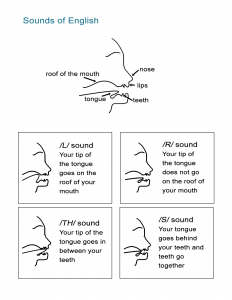
These English pronunciation exercises teach students how to place their tongues when they speak syllables.
For example, the /th/ sound puts the tip of the tongue in between your teeth. Whereas, the /s/ sound keeps the tongue behind the teeth.
2. Pronunciation Pyramid
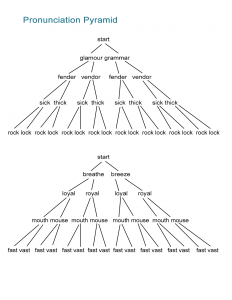
First, everyone starts at the top of the pyramid. Next, the teacher says at a level below. Individually, students circle the word they hear.
At the bottom of the pyramid, the teacher says the word, and the students circle what they hear. The teacher also keeps track going down the pyramid. Where do you finish? It’s fun to see.
3. Minimal Pairs
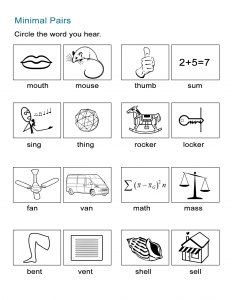
For each pair, the words sound extremely similar. But they are different. Students have to keep a keen ear on what they hear.
As the teacher reads the box of his/her choice, students circle the word they hear. When you go through all the minimal pairs, check their understanding by correcting the papers.
4. Minimal Pairs Game Cards
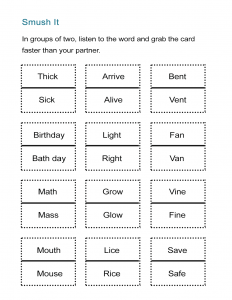
Beforehand, the teacher has to print off the handout. They cut out every word and spreads them out on pairs of desks.
In pairs, students carefully listen to the teacher. Next, they have to find the word they hear faster than their neighbor. Finally, the student who grabs the card faster keeps it. At the end of the game, the student with the most cards is the winner.
5. Tongue Twisters
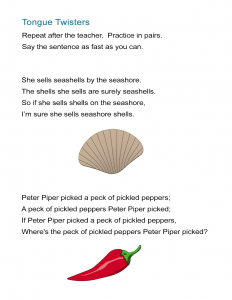
Oddly enough, tongue twisters are an effortless way to get students talking. I can’t put my finger on it why… but they probably love the challenge of it.
First, students repeat each line after the teacher. Next, the teacher demonstrates the tongue twister with lightning speed. Now, ask for volunteers to try to do it faster.
6. Similar Sentences
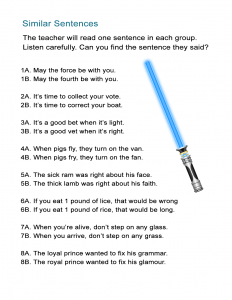
How much do your students pay attention to detail? Each sentence sounds similar but they are different.
You can read each sentence yourself. Or you can have your students read them. Can they find the difference between them?
7. Listening Test
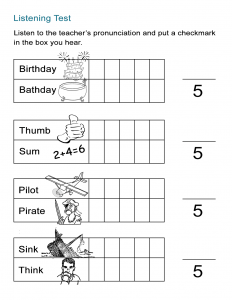
This is your basic type of listening test. Can they differentiate each unique sound when you read them?
First, mix up the sounds. Next, keep track of the sounds you say. Finally, correct their papers to test their syllable recognition.
8. Rhyme Time
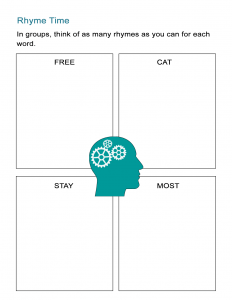
First, put students in groups of 3 or 4. Next, get your students to think of as many rhymes as possible for each box.
It’s the classic brainstorming competition. Bring out your stopwatch because the group with the most rhymes wins.
9. Tongue Twisters

Oddly enough, tongue twisters are an effortless way to get your students talking. Practice each tongue twister, and have your students try to show off their English skills.
Pro tip: they love it if you can say a tongue twister in their native language.
10. Valentine’s Day Cards

In our Valentine’s Day Card Sheet, students finish the rhyme from the classic poem “Roses are red, violets are blue…”.
First, hand out the paper with an example rhyme for the poem. Next, review it with your students. Finally, let your students create a rhyme for “Roses are Red, Violets are Blue”.
English Pronunciation Exercises
Speaking like a true native English speaker is one of the goals of an English Language Learner. A good place to start achieving this goal is by meticulously going through all the sounds of English.
Of course, just basic conversation is important too. That’s where you can practice these 101 ESL conversation topics to get them speaking.
These 10 English pronunciation exercises can be reworked in several ways – in pairs, individually, or as a class.
How do you like teaching pronunciation? What works and what doesn’t? Please let us know what are some of your English pronunciation exercises in the comment section below.

Are you looking for practice exercises to improve your English pronunciation?
If yes, you’ve come to the right place.
This page contains pronunciation exercises organized into 5 chapters:
- Chapter 1: The Main Sounds of English
- Chapter 2: Stress and Intonation
- Chapter 3: Word Connections
- Chapter 4: Reduced Sounds
- Chapter 5: Common Pronunciation Mistakes
Improving your English pronunciation is hard. But you can make it easier by focusing on only one pronunciation skill at a time.
That’s why the exercises are organized into five chapters. Focus on one chapter at a time so you don’t feel overwhelmed.
There are a lot of exercises on this page. If you don’t have time to practice them all, focus on the ones that address your pronunciation problems.
Chapter 1: The Main Sounds of English

In this chapter, you’ll find exercises to help you pronounce every main sound in English correctly.
English has a lot of words that sound similar (heel vs. hill, sell vs. sale, pool vs. pull). It’s important to pronounce them correctly.
In many of the exercises, you’ll be practicing two similar sounds at the same time. This is an effective way to practice English pronunciation.
The Vowel Sounds
English has about 15 main vowel sounds. If your native language has fewer vowel sounds, you probably speak English using only the sounds that are present in your native language.
As a result, you might pronounce two different words the same way because you can’t hear the differences between them. So, let’s do some practice to fix that.
/i/ (heat) and /I/ (hit)
- E & I (Ronnie@EngVid)
- “heel” or “hill”? (Lisa Mojsin@AccurateEnglish)
- Sit /i/ vs Seat /i:/ (Molly@ShawEnglish)
/eɪ/ (late) and /ɛ/ (let)
- Met /e/ vs Mate /ei/ (Molly@ShawEnglish)
- How to say SELL and SALE (Tarle Speech)
/ɛ/ (bed) and /æ/ (bad)
- EH [ɛ] vs. AA [æ] Vowels (Rachel’s English)
- Bad /æ/ vs Bed /e/ (Molly@ShawEnglish)
- A & E – Man vs. Men (Alex@EngVid)
/æ/ (hat) and /ɑ/ (hot)
- Vowel Pronunciation – A & O (Ronnie@EngVid)
/ɑ/ (calm) and /ɘ/ (come)
- Focus on /ə/ and /ɑ/ (DVCESL72)
/æ/ (bat) and /ɘ (but)
- Bat /æ/ vs But /Ʌ/ (Molly@ShawEnglish)
- Cap & Cup (JefftheESLCoach)
/ɔ/ (want) and /oʊ/ (won’t)
- “WON’T” and “WANT” pronunciation/difference (Coach Shane)
- Want vs Won’t (American English n’ culture with Philochko)
- Poke /əʊ/ vs Pork /or/ (Molly@ShawEnglish)
- Law vs Low (American English n’ culture with Philochko)
/ʊ/ (full) and /u/ (fool)
- u (uh/oo) (Ronnie@EngVid)
- How to say POOL and PULL (Tarle Speech and Language Services)
- FULL vs FOOL: Pronunciation difference (Coach Shane)
/ɑ/ (lock) VS. /ɘ/ (luck) VS. /ʊ/ (look)
- LUCK, LOCK and LOOK (Coach Shane)
/ɘr/ (heard) and /ɑ/ (hard)
- Far /ar/ vs Fur /ur/ (Molly@ShawEnglish)
- How to pronounce “Hard” and “Heard” (Tarle Speech and Language Services)
- How to say STAR and STIR (Tarle Speech and Language Services)
/ɘr/ (work) and /ɔ/ (walk)
- walk-work 미국발음 (Coach Shane)
/aɪ/ (time, nine, dry, etc.)
- How to Pronounce AI [aɪ] diphthong (Rachel’s English)
/aʊ/ (south, house, cow, etc.)
- How to Pronounce OW [aʊ] diphthong (Rachel’s English)
/ɔɪ/ (oil, choice, voice, etc.)
- How to Pronounce OY diphthong (Rachel’s English)
The Consonant Sounds
Let’s practice the consonants sounds, which are just as important as the vowel sounds.
When do you an exercise, it’s helpful to pay attention to the mouth movements of the presenter.
/t/ (cotton, better, etc.)
- American T sound (Lisa Mojsin@AccurateEnglish)
- Mastering the American “T” sound! (American English n’ culture with Philochko)
- Silent T: often, listen, castle… (Emma@EngVid)
Understanding voiced and unvoiced consonants
- voiced and unvoiced consonants (LearnAmericanEnglishOnline)
- HAVE vs HALF pronunciation (Coach Shane)
- Final voiced consonants (Lynn Bo@Accent Master)
/s/ (Sue) and /z/ (zoo)
- English: How to Pronounce S and Z consonant (Rachel’s English)
- How to pronounce words ending in S (Emma@EngVid)
- S or Z (Britlish – Linguaspectrum)
- S or Z – Ice or Eyes (iswearenglish)
- Confused Words – ADVICE & ADVISE (Rebecca@EngVid)
Stop Consonants
- How to Pronounce Stop Consonants (Rachel’s English)
/h/ (horse, hot, etc)
- How to pronounce ‘H’ in English — not ‘A’ or ‘R’! (Ronnie@EngVid)
/dʒ/ (drawer, education, schedule, etc)
- Why is there a “J” sound in the DR of “DRAWER”? (Coach Shane)
- Pronunciation – DU – education, schedule, individual, procedure… (Emma@EngVid)
/dʒ/ (job) and /tʃ/ (chop)
- How do you pronounce “j” and “ch” as in “job” and “chop”? (Coach Shane)
- How to Pronounce CH [ʧ] and JJ [ʤ] Sounds (Rachel’s English)
Words Ending in –ed
- How to Pronounce -ed verb endings (Rachel’s English)
/θ/ (this, think, thank, etc)
- “TH” Pronunciation (Dave Sconda@English Meeting)
/θ/ (thin) and /s/ (sin)
- English Pronunciation – Th & S (Ronnie@EngVid)
/θ/ (they) and /d/ (day)
- the /TH/ & /D/ Sound (Kweku Moore)
- How to say THEY and DAY (Tarle Speech and Language Services)
/l/ (light) and /r/ (right)
- Cool Tongue twisters for the R and L sound! (American English n’ culture with Philochko)
- L and R – Part 1 (Teacher Melanie)
- L and R – Part 2 – Exercises (Teacher Melanie)
- Light /l/ vs Right /r/ (Molly@ShawEnglish)
/l/ and /n/
- Pronunciation of “L” and “N” in English (Anna V)
/v/ (van) and /b/ (ban)
- B & V (Jon@EngVid)
- /v/ and /b/ (Teacher Melanie)
- How to say BEER and VEER
/b/ (bee) and /p/ (pee)
- Bee /b/ vs Pee /p/ (Molly@ShawEnglish)
/p/ (pan) and /f/ (fan)
- How to pronounce P and F in English (Ronnie@EngVid)
/v/ (verse) and /w/ (worse)
- V & W (Ronnie@EngVid)
/j/ (jet) and /y/ (yet)
- J & Y (Ronnie@EngVid)
- the /J/ & /Y/ Sound (Kweku Moore)
/j/ (budge) and /z/ (buzz)
- “z” vs “j” pronunciation (Coach Shane)
- ZZ vs. JJ (buzz vs. budge) Sounds (Rachel’s English)
/ʃ/ (ship) and /tʃ/ (chip)
- ‘sh’ / ʃ / vs. ‘ch’ / tʃ / sounds (Teacher Melanie)
- How to say CH & SH (Ronnie@EngVid)
/n/ (thin) and /ŋ/ (thing)
- How to End a Word in N [n] or NG [ŋ] (Rachel’s English)
- Thin /n/ vs Thing /ng/ (Molly@ShawEnglish)
Consonant Clusters
- How to Pronounce the TR Consonant Cluster (Rachel’s English)
- How to Pronounce the SHR Consonant Cluster (Rachel’s English)
- S Consonant Clusters (Rachel’s English)
- “rl” (pearl) pronunciation (Coach Shane)
- “thr” (three/through) pronunciation (Coach Shane)
By the way, do you want to improve your spoken English?
If so, enter your email address to join my English speaking course:
Chapter 2: Stress and Intonation

When we say someone has a strong accent, it means they speak English with incorrect stress and intonation patterns, making them difficult to understand.
So, if you want others to understand your spoken English, practice the exercises in this chapter carefully.
Syllable Stress
A syllable is the smallest unit of pronunciation. (The word “water” has two syllables. The word “inferno” has three.)
Stressing the wrong syllable in a word can cause misunderstandings because people think you are saying a different word.
- 2-Syllable Words Stress (Rachel’s English)
- Word Stress and Three Syllable Words (Rachel’s English)
- Difference in stress between nouns and verbs (Jade@EngVid)
Word Stress
Native speakers always stress certain words within sentences.
If you learn to stress the right words your speech will have a natural rhythm similar to that of native speakers.
- How does stress change the meaning of a sentence? (Adam@EngVid)
- Word Stress: content Words (Rachel’s English)
- Word Stress and Verbs (Rachel’s English)
Intonation
Intonation is like the melody of a song.
When you listen to native speakers, you can hear their speech rise and fall in pitch. Some syllables are high in pitch. Some are low.
Intonation is important because it tells the listener whether you’re finished talking or whether you have more to say; whether you’re asking a question or making a statement.
- Rising and Falling Intonation (English Pronunciation Roadmap)
- Questions vs. Statements (Rachel’s English)
- Questions and Intonation: Up or Down? (Rachel’s English)
Chapter 3: Word Connections

This chapter will help you sound more like a native speaker. You’ll practice “linking words” together so that your speech flows better and sounds more natural.
Contractions
- How to Pronounce Contractions (Rachel’s English)
- How to Pronounce N’T Contractions (Rachel’s English)
Word Linking
- Linking: Consonant to Vowel (Rachel’s English)
- Linking Consonant to Consonant (Rachel’s English)
- Linking: Vowel to Vowel (Rachel’s English)
Chapter 4: Reduced Sounds

When speaking, native speakers don’t pronounce every syllable clearly. Instead, they “reduce” certain sounds, making it easier to speak.
- Reduction: the word FOR (Rachel’s English)
- How to Pronounce the Word OR (Rachel’s English)
- How to Reduce ‘THAT’ (Rachel’s English)
- How to Pronounce the Word ‘TO’ (Rachel’s English)
- How to Pronounce ‘to the’ in a Sentence (Rachel’s English)
- Reduction: the word AT (Rachel’s English)
Chapter 5: Common Pronunciation Mistakes
A few bonus exercises for you to practice.
- How to Pronounce Can vs. Can’t (Rachel’s English)
- How to pronounce words ending in S (Emma@EngVid)
- How to Pronounce -ed verb endings (Rachel’s English)
- words ending with X, T, CK (Ronnie@EngVid)
- How to pronounce PEANUTS (not penis) (Tarle Speech and Language Services)
Other Ways to Practice Your English Pronunciation
Using the lessons on this page is one way to improve your pronunciation and accent.
But there are two more methods you can use:
- Practice the Parrot technique. (Imitate native speakers.)
- Do an accent inspection. (Compare your accent with the native accent.)
If you combine all three methods together, the results will be amazing!
So if you want to learn more, check out my article on how to improve your English pronunciation. You’ll learn a complete process for sounding like a native.




